seats Hyundai Terracan 2003 Owner's Manual
[x] Cancel search | Manufacturer: HYUNDAI, Model Year: 2003, Model line: Terracan, Model: Hyundai Terracan 2003Pages: 349, PDF Size: 4.56 MB
Page 19 of 349
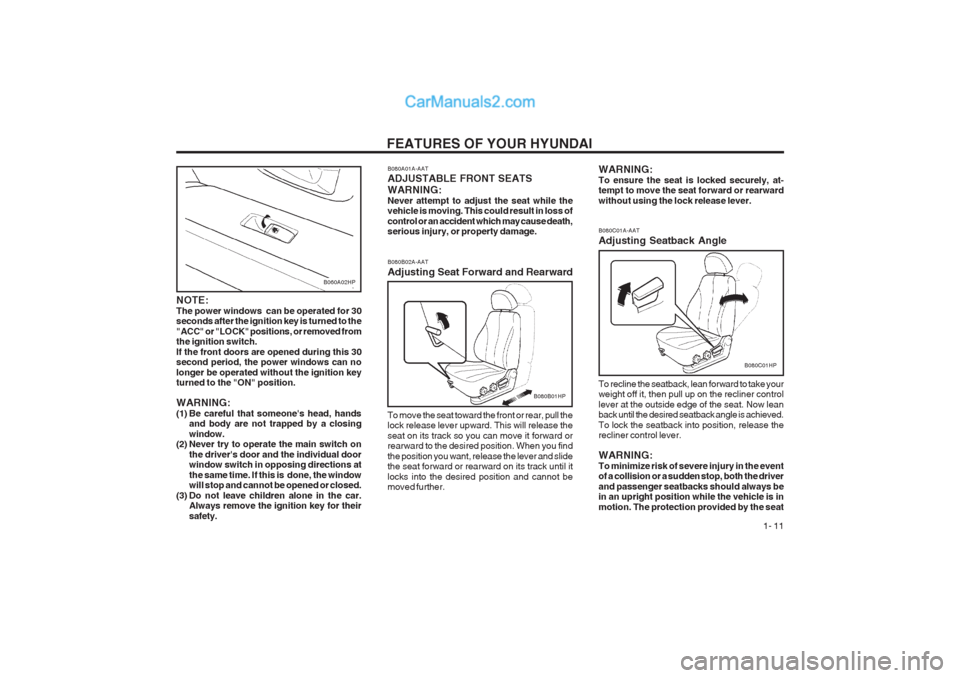
FEATURES OF YOUR HYUNDAI 1- 11
B060A02HP
NOTE: The power windows can be operated for 30 seconds after the ignition key is turned to the "ACC" or "LOCK" positions, or removed from the ignition switch. If the front doors are opened during this 30 second period, the power windows can no longer be operated without the ignition key turned to the "ON" position. WARNING:
(1) Be careful that someone's head, hands and body are not trapped by a closingwindow.
(2) Never try to operate the main switch on
the driver's door and the individual door window switch in opposing directions at the same time. If this is done, the window will stop and cannot be opened or closed.
(3) Do not leave children alone in the car. Always remove the ignition key for their safety. To move the seat toward the front or rear, pull the lock release lever upward. This will release the seat on its track so you can move it forward or rearward to the desired position. When you find the position you want, release the lever and slide the seat forward or rearward on its track until it locks into the desired position and cannot be moved further.
B080A01A-AAT ADJUSTABLE FRONT SEATS WARNING: Never attempt to adjust the seat while the vehicle is moving. This could result in loss of control or an accident which may cause death, serious injury, or property damage. B080B02A-AAT Adjusting Seat Forward and Rearward
B080B01HP
B080C01A-AAT Adjusting Seatback Angle
To recline the seatback, lean forward to take your weight off it, then pull up on the recliner control lever at the outside edge of the seat. Now lean back until the desired seatback angle is achieved. To lock the seatback into position, release the recliner control lever. WARNING: To minimize risk of severe injury in the event of a collision or a sudden stop, both the driver and passenger seatbacks should always be in an upright position while the vehicle is in motion. The protection provided by the seat
B080C01HP
WARNING: To ensure the seat is locked securely, at- tempt to move the seat forward or rearward without using the lock release lever.
Page 22 of 349
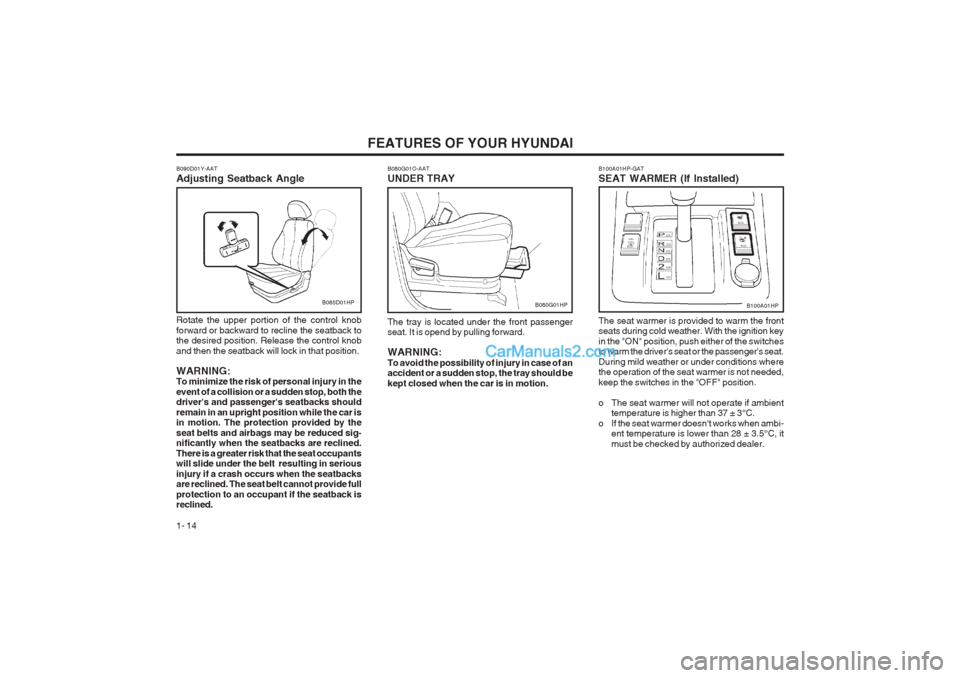
FEATURES OF YOUR HYUNDAI
1- 14
B100A01HP-GAT SEAT WARMER (If Installed) The seat warmer is provided to warm the front seats during cold weather. With the ignition key in the "ON" position, push either of the switches to warm the driver's seat or the passenger's seat. During mild weather or under conditions where the operation of the seat warmer is not needed, keep the switches in the "OFF" position.
o The seat warmer will not operate if ambient temperature is higher than 37 ± 3°C.
o If the seat warmer doesn't works when ambi- ent temperature is lower than 28 ± 3.5°C, it must be checked by authorized dealer.
B100A01HP
B080G01O-AAT UNDER TRAY
B080G01HP
The tray is located under the front passenger seat. It is opend by pulling forward. WARNING: To avoid the possibility of injury in case of an accident or a sudden stop, the tray should be kept closed when the car is in motion.B085D01HP
B090D01Y-AAT Adjusting Seatback Angle Rotate the upper portion of the control knob forward or backward to recline the seatback to the desired position. Release the control knob and then the seatback will lock in that position. WARNING: To minimize the risk of personal injury in the event of a collision or a sudden stop, both the driver's and passenger's seatbacks should remain in an upright position while the car is in motion. The protection provided by the seat belts and airbags may be reduced sig- nificantly when the seatbacks are reclined. There is a greater risk that the seat occupants will slide under the belt resulting in serious injury if a crash occurs when the seatbacks are reclined. The seat belt cannot provide full protection to an occupant if the seatback is reclined.
Page 27 of 349
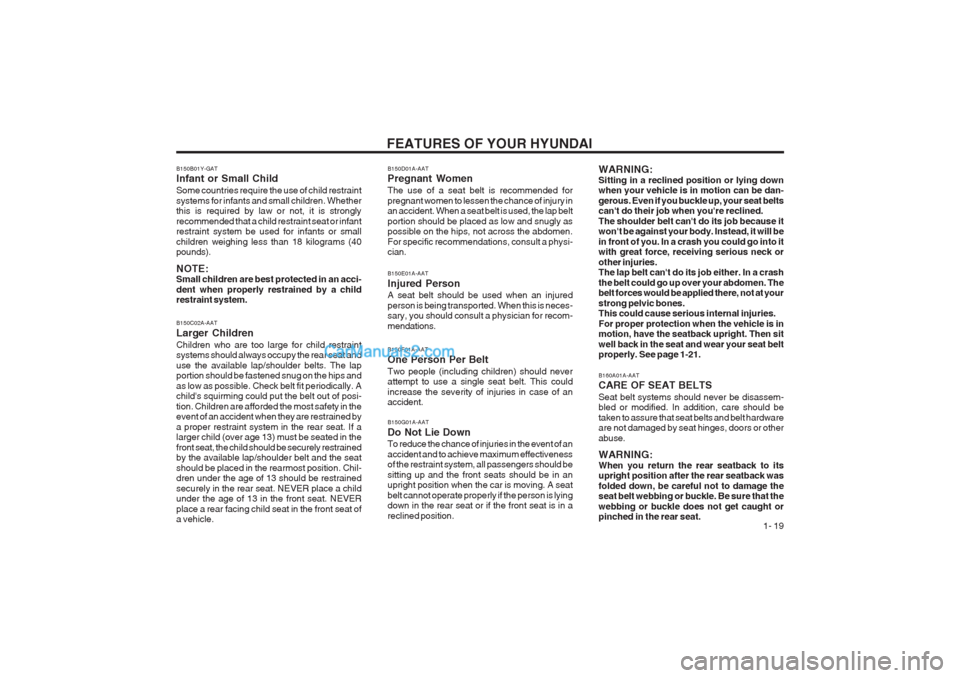
FEATURES OF YOUR HYUNDAI 1- 19
B150B01Y-GAT Infant or Small Child Some countries require the use of child restraint systems for infants and small children. Whether this is required by law or not, it is strongly recommended that a child restraint seat or infant
restraint system be used for infants or small children weighing less than 18 kilograms (40 pounds). NOTE: Small children are best protected in an acci- dent when properly restrained by a child restraint system. B150C02A-AAT Larger ChildrenChildren who are too large for child restraint systems should always occupy the rear seat and use the available lap/shoulder belts. The lap portion should be fastened snug on the hips and as low as possible. Check belt fit periodically. A child's squirming could put the belt out of posi- tion. Children are afforded the most safety in the event of an accident when they are restrained by a proper restraint system in the rear seat. If a larger child (over age 13) must be seated in the front seat, the child should be securely restrained by the available lap/shoulder belt and the seat should be placed in the rearmost position. Chil- dren under the age of 13 should be restrained securely in the rear seat. NEVER place a child under the age of 13 in the front seat. NEVER place a rear facing child seat in the front seat of a vehicle.
B150E01A-AAT Injured Person A seat belt should be used when an injured person is being transported. When this is neces- sary, you should consult a physician for recom- mendations. B150F01A-AAT One Person Per BeltTwo people (including children) should never attempt to use a single seat belt. This could increase the severity of injuries in case of an accident. B150G01A-AAT Do Not Lie Down To reduce the chance of injuries in the event of an accident and to achieve maximum effectiveness of the restraint system, all passengers should be sitting up and the front seats should be in an upright position when the car is moving. A seat belt cannot operate properly if the person is lying down in the rear seat or if the front seat is in a reclined position.
B150D01A-AAT Pregnant Women The use of a seat belt is recommended for pregnant women to lessen the chance of injury in an accident. When a seat belt is used, the lap belt portion should be placed as low and snugly as possible on the hips, not across the abdomen. For specific recommendations, consult a physi- cian.
WARNING: Sitting in a reclined position or lying down when your vehicle is in motion can be dan- gerous. Even if you buckle up, your seat belts can't do their job when you're reclined. The shoulder belt can't do its job because it won't be against your body. Instead, it will be in front of you. In a crash you could go into it with great force, receiving serious neck or other injuries. The lap belt can't do its job either. In a crash the belt could go up over your abdomen. The belt forces would be applied there, not at your strong pelvic bones. This could cause serious internal injuries. For proper protection when the vehicle is in motion, have the seatback upright. Then sit well back in the seat and wear your seat belt properly. See page 1-21. B160A01A-AAT CARE OF SEAT BELTS Seat belt systems should never be disassem- bled or modified. In addition, care should be taken to assure that seat belts and belt hardware are not damaged by seat hinges, doors or other abuse. WARNING: When you return the rear seatback to its upright position after the rear seatback was folded down, be careful not to damage the seat belt webbing or buckle. Be sure that the webbing or buckle does not get caught or pinched in the rear seat.
Page 31 of 349
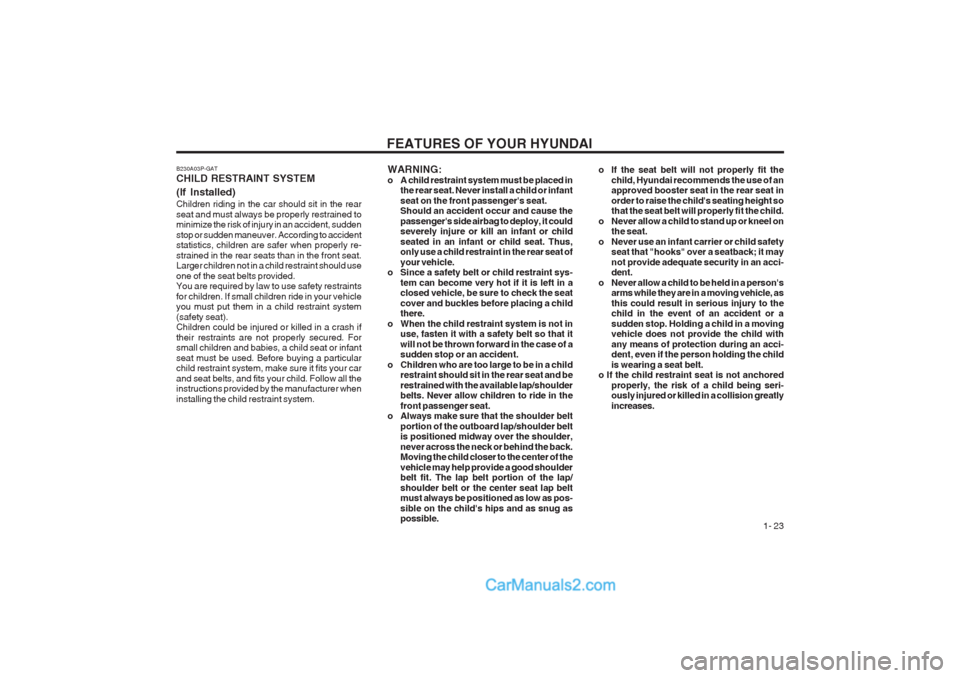
FEATURES OF YOUR HYUNDAI 1- 23
B230A03P-GAT CHILD RESTRAINT SYSTEM (If Installed) Children riding in the car should sit in the rear seat and must always be properly restrained to minimize the risk of injury in an accident, sudden stop or sudden maneuver. According to accident statistics, children are safer when properly re- strained in the rear seats than in the front seat. Larger children not in a child restraint should use one of the seat belts provided. You are required by law to use safety restraints for children. If small children ride in your vehicle you must put them in a child restraint system (safety seat). Children could be injured or killed in a crash if their restraints are not properly secured. For small children and babies, a child seat or infant seat must be used. Before buying a particular child restraint system, make sure it fits your car and seat belts, and fits your child. Follow all the instructions provided by the manufacturer when installing the child restraint system.
WARNING:
o A child restraint system must be placed in
the rear seat. Never install a child or infantseat on the front passenger's seat. Should an accident occur and cause the
passenger's side airbag to deploy, it could severely injure or kill an infant or child seated in an infant or child seat. Thus, only use a child restraint in the rear seat of your vehicle.
o Since a safety belt or child restraint sys-
tem can become very hot if it is left in a closed vehicle, be sure to check the seat cover and buckles before placing a child there.
o When the child restraint system is not in use, fasten it with a safety belt so that it will not be thrown forward in the case of a sudden stop or an accident.
o Children who are too large to be in a child restraint should sit in the rear seat and be restrained with the available lap/shoulder belts. Never allow children to ride in the front passenger seat.
o Always make sure that the shoulder belt
portion of the outboard lap/shoulder belt is positioned midway over the shoulder, never across the neck or behind the back. Moving the child closer to the center of the vehicle may help provide a good shoulder belt fit. The lap belt portion of the lap/ shoulder belt or the center seat lap belt must always be positioned as low as pos- sible on the child's hips and as snug as possible. o If the seat belt will not properly fit the
child, Hyundai recommends the use of anapproved booster seat in the rear seat in order to raise the child's seating height so that the seat belt will properly fit the child.
o Never allow a child to stand up or kneel on the seat.
o Never use an infant carrier or child safety seat that "hooks" over a seatback; it may not provide adequate security in an acci- dent.
o Never allow a child to be held in a person's arms while they are in a moving vehicle, as this could result in serious injury to the child in the event of an accident or a sudden stop. Holding a child in a moving vehicle does not provide the child with any means of protection during an acci- dent, even if the person holding the child is wearing a seat belt.
o If the child restraint seat is not anchored
properly, the risk of a child being seri- ously injured or killed in a collision greatly increases.
Page 32 of 349
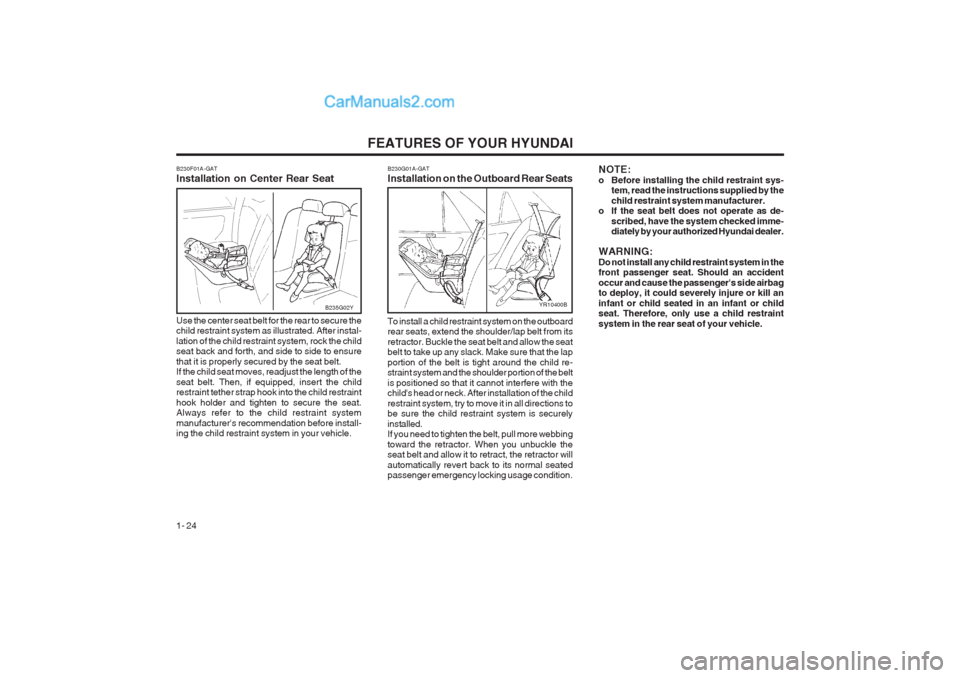
FEATURES OF YOUR HYUNDAI
1- 24
B230F01A-GAT Installation on Center Rear Seat Use the center seat belt for the rear to secure the child restraint system as illustrated. After instal- lation of the child restraint system, rock the child seat back and forth, and side to side to ensure that it is properly secured by the seat belt. If the child seat moves, readjust the length of the seat belt. Then, if equipped, insert the child restraint tether strap hook into the child restraint hook holder and tighten to secure the seat. Always refer to the child restraint system manufacturer's recommendation before install- ing the child restraint system in your vehicle.
B230G01A-GAT Installation on the Outboard Rear Seats To install a child restraint system on the outboard rear seats, extend the shoulder/lap belt from its retractor. Buckle the seat belt and allow the seat belt to take up any slack. Make sure that the lap portion of the belt is tight around the child re- straint system and the shoulder portion of the belt is positioned so that it cannot interfere with the child's head or neck. After installation of the child restraint system, try to move it in all directions to be sure the child restraint system is securely installed. If you need to tighten the belt, pull more webbing toward the retractor. When you unbuckle the seat belt and allow it to retract, the retractor will automatically revert back to its normal seated passenger emergency locking usage condition.
B235G02YYR10400B
NOTE:
o Before installing the child restraint sys-
tem, read the instructions supplied by thechild restraint system manufacturer.
o If the seat belt does not operate as de-
scribed, have the system checked imme- diately by your authorized Hyundai dealer.
WARNING: Do not install any child restraint system in the front passenger seat. Should an accident occur and cause the passenger's side airbag to deploy, it could severely injure or kill an infant or child seated in an infant or child seat. Therefore, only use a child restraint system in the rear seat of your vehicle.
Page 34 of 349
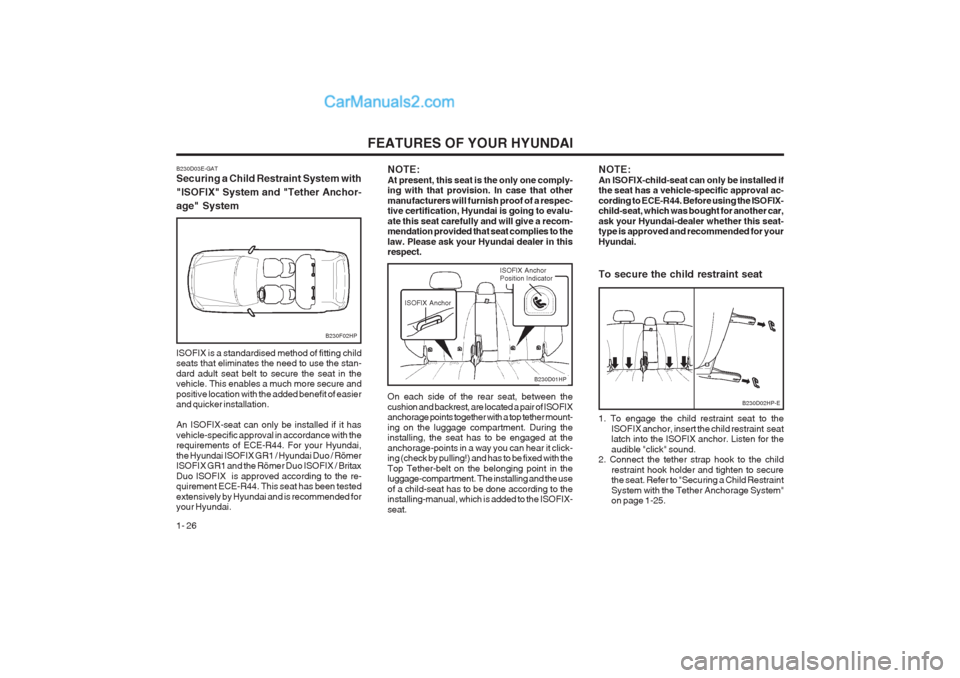
FEATURES OF YOUR HYUNDAI
1- 26
B230F02HP
B230D03E-GAT Securing a Child Restraint System with "ISOFIX" System and "Tether Anchor-age" System ISOFIX is a standardised method of fitting child seats that eliminates the need to use the stan- dard adult seat belt to secure the seat in the vehicle. This enables a much more secure and positive location with the added benefit of easier and quicker installation. An ISOFIX-seat can only be installed if it has vehicle-specific approval in accordance with the requirements of ECE-R44. For your Hyundai, the Hyundai ISOFIX GR1 / Hyundai Duo / Römer ISOFIX GR1 and the Römer Duo ISOFIX / Britax Duo ISOFIX is approved according to the re- quirement ECE-R44. This seat has been tested extensively by Hyundai and is recommended for your Hyundai. NOTE: At present, this seat is the only one comply- ing with that provision. In case that other manufacturers will furnish proof of a respec- tive certification, Hyundai is going to evalu- ate this seat carefully and will give a recom- mendation provided that seat complies to the law. Please ask your Hyundai dealer in this respect. On each side of the rear seat, between the cushion and backrest, are located a pair of ISOFIX anchorage points together with a top tether mount- ing on the luggage compartment. During the installing, the seat has to be engaged at the anchorage-points in a way you can hear it click- ing (check by pulling!) and has to be fixed with the Top Tether-belt on the belonging point in the luggage-compartment. The installing and the use of a child-seat has to be done according to the installing-manual, which is added to the ISOFIX- seat.
B230D02HP-E
NOTE: An ISOFIX-child-seat can only be installed if the seat has a vehicle-specific approval ac- cording to ECE-R44. Before using the ISOFIX- child-seat, which was bought for another car, ask your Hyundai-dealer whether this seat- type is approved and recommended for your Hyundai. To secure the child restraint seat 1. To engage the child restraint seat to the
ISOFIX anchor, insert the child restraint seat latch into the ISOFIX anchor. Listen for the audible "click" sound.
2. Connect the tether strap hook to the child
restraint hook holder and tighten to secure the seat. Refer to "Securing a Child Restraint
System with the Tether Anchorage System" on page 1-25.
B230D01HP
ISOFIX Anchor ISOFIX Anchor Position Indicator
Page 35 of 349
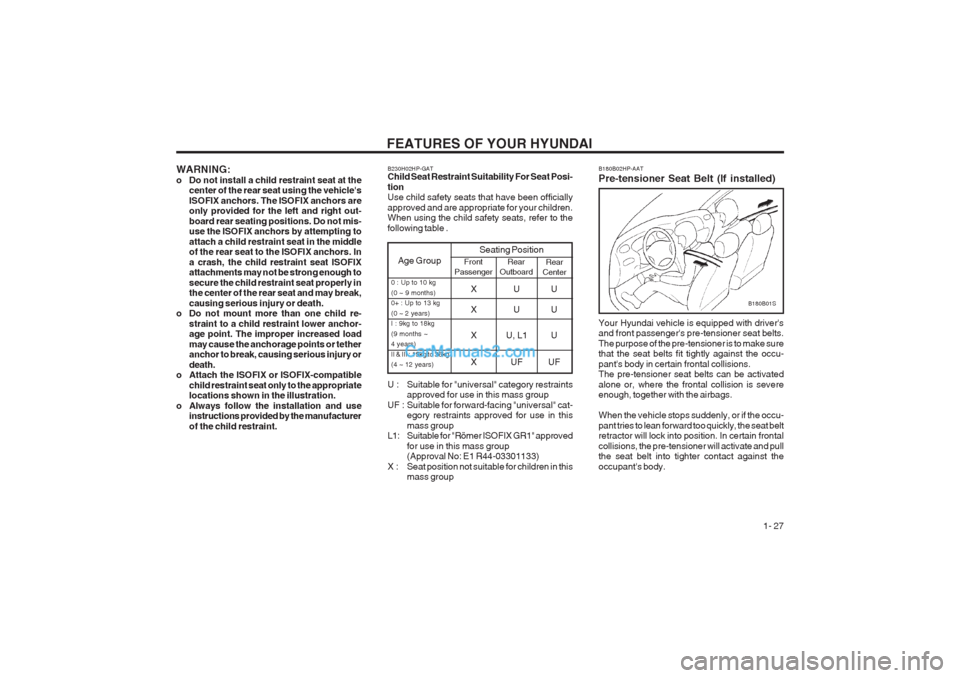
FEATURES OF YOUR HYUNDAI 1- 27
WARNING:
o Do not install a child restraint seat at the
center of the rear seat using the vehicle'sISOFIX anchors. The ISOFIX anchors are only provided for the left and right out- board rear seating positions. Do not mis- use the ISOFIX anchors by attempting to attach a child restraint seat in the middle of the rear seat to the ISOFIX anchors. In a crash, the child restraint seat ISOFIX attachments may not be strong enough to secure the child restraint seat properly in the center of the rear seat and may break, causing serious injury or death.
o Do not mount more than one child re-
straint to a child restraint lower anchor- age point. The improper increased load may cause the anchorage points or tether anchor to break, causing serious injury or death.
o Attach the ISOFIX or ISOFIX-compatible
child restraint seat only to the appropriate locations shown in the illustration.
o Always follow the installation and use instructions provided by the manufacturer of the child restraint.
Age Group Seating PositionFront
Passenger Rear
Outboard Rear
Center
0 : Up to 10 kg (0 ~ 9 months) 0+ : Up to 13 kg (0 ~ 2 years) I : 9kg to 18kg (9 months ~ 4 years) II & III : 15kg to 36kg (4 ~ 12 years)XUU
XUU
X U, L1 U XU FUF
B230H02HP-GAT Child Seat Restraint Suitability For Seat Posi- tion Use child safety seats that have been officially approved and are appropriate for your children. When using the child safety seats, refer to the following table .
U : Suitable for "universal" category restraints
approved for use in this mass group
UF : Suitable for forward-facing "universal" cat- egory restraints approved for use in this mass group
L1: Suitable for "Römer ISOFIX GR1" approved
for use in this mass group (Approval No: E1 R44-03301133)
X : Seat position not suitable for children in this mass group Your Hyundai vehicle is equipped with driver'sand front passenger's pre-tensioner seat belts. The purpose of the pre-tensioner is to make sure that the seat belts fit tightly against the occu- pant's body in certain frontal collisions. The pre-tensioner seat belts can be activated alone or, where the frontal collision is severe enough, together with the airbags. When the vehicle stops suddenly, or if the occu- pant tries to lean forward too quickly, the seat belt retractor will lock into position. In certain frontal collisions, the pre-tensioner will activate and pull the seat belt into tighter contact against the occupant's body.
B180B02HP-AAT Pre-tensioner Seat Belt (If installed)
B180B01S
Page 183 of 349
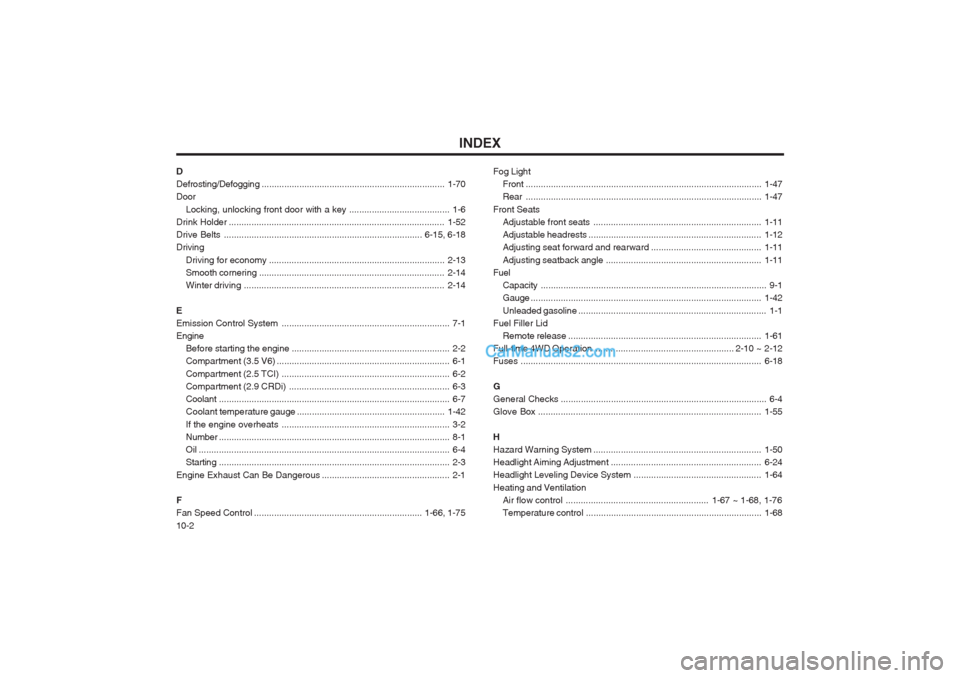
INDEX
10-2
D Defrosting/Defogging
......................................................................... 1-70
Door
Locking, unlocking front door with a key ........................................ 1-6
Drink Holder ...................................................................................... 1-52
Drive Belts ............................................................................... 6-15, 6-18
Driving
Driving for economy ...................................................................... 2-13
Smooth cornering .......................................................................... 2-14
Winter driving ................................................................................ 2-14
E
Emission Control System ................................................................... 7-1
Engine
Before starting the engine ............................................................... 2-2
Compartment (3.5 V6) ..................................................................... 6-1
Compartment (2.5 TCI) ................................................................... 6-2
Compartment (2.9 CRDi) ................................................................ 6-3
Coolant ............................................................................................ 6-7
Coolant temperature gauge ........................................................... 1-42
If the engine overheats ................................................................... 3-2
Number ............................................................................................ 8-1
Oil .................................................................................................... 6-4Starting ............................................................................................ 2-3
Engine Exhaust Can Be Dangerous ................................................... 2-1
FFan Speed Control ................................................................... 1-66, 1-75 Fog Light
Front .............................................................................................. 1-47
Rear .............................................................................................. 1-47
Front Seats Adjustable front seats ................................................................... 1-11
Adjustable headrests ..................................................................... 1-12
Adjusting seat forward and rearward ............................................1-11
Adjusting seatback angle .............................................................. 1-11
Fuel Capacity .......................................................................................... 9-1
Gauge ............................................................................................ 1-42
Unleaded gasoline ........................................................................... 1-1
Fuel Filler Lid Remote release ............................................................................. 1-61
Full-time 4WD Operation ....................................................... 2-10 ~ 2-12
Fuses ................................................................................................ 6-18
GGeneral Checks .................................................................................. 6-4
Glove Box ......................................................................................... 1-55
HHazard Warning System ................................................................... 1-50
Headlight Aiming Adjustment ............................................................ 6-24
Headlight Leveling Device System ...................................................1-64
Heating and Ventilation Air flow control ......................................................... 1-67 ~ 1-68, 1-76
Temperature control ...................................................................... 1-68
Page 208 of 349
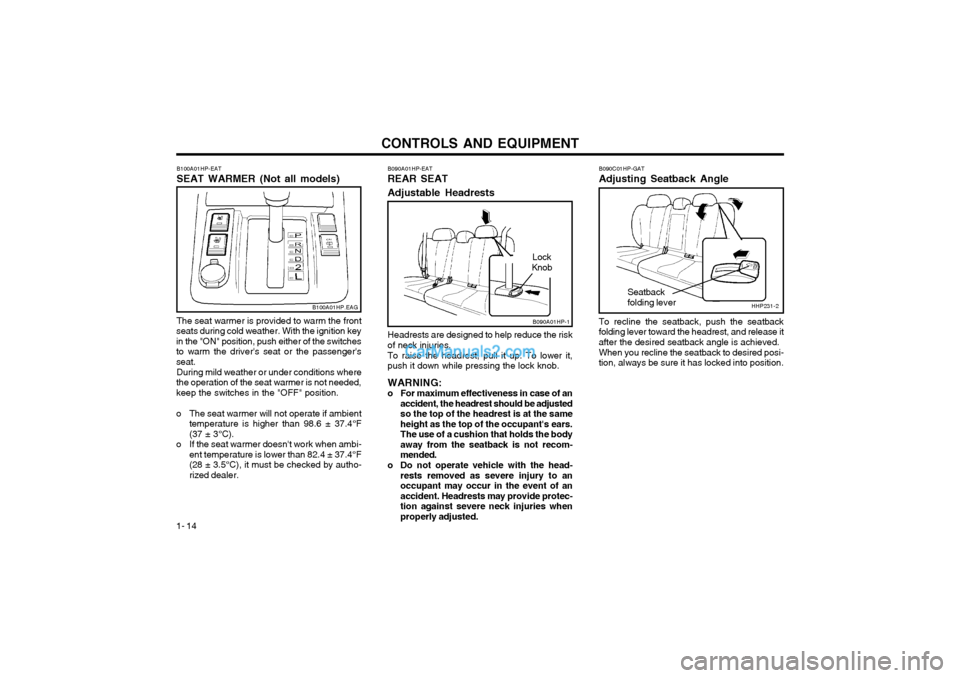
CONTROLS AND EQUIPMENT
1- 14
B100A01HP-EAT SEAT WARMER (Not all models) The seat warmer is provided to warm the front
seats during cold weather. With the ignition key in the "ON" position, push either of the switchesto warm the driver's seat or the passenger'sseat.
During mild weather or under conditions where
the operation of the seat warmer is not needed,keep the switches in the "OFF" position.
o The seat warmer will not operate if ambient temperature is higher than 98.6 ± 37.4°F (37 ± 3°C).
o If the seat warmer doesn't work when ambi- ent temperature is lower than 82.4 ± 37.4°F(28 ± 3.5°C), it must be checked by autho-rized dealer.
B100A01HP.EAGHHP231-2
B090A01HP-EAT REAR SEAT Adjustable Headrests Headrests are designed to help reduce the risk of neck injuries. To raise the headrest, pull it up. To lower it, push it down while pressing the lock knob. WARNING:
o For maximum effectiveness in case of an accident, the headrest should be adjusted so the top of the headrest is at the sameheight as the top of the occupant's ears.
The use of a cushion that holds the bodyaway from the seatback is not recom-mended.
o Do not operate vehicle with the head- rests removed as severe injury to anoccupant may occur in the event of anaccident. Headrests may provide protec-tion against severe neck injuries whenproperly adjusted. B090C01HP-GAT Adjusting Seatback Angle To recline the seatback, push the seatback folding lever toward the headrest, and release itafter the desired seatback angle is achieved. When you recline the seatback to desired posi- tion, always be sure it has locked into position.
Seatback folding lever
B090A01HP-1
Lock
Knob
Page 210 of 349
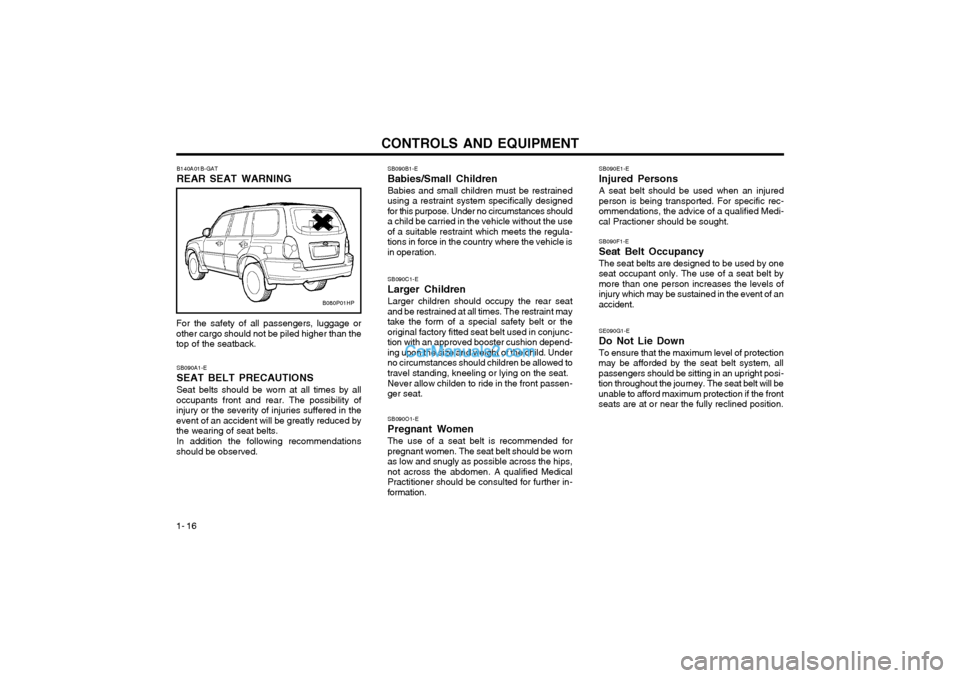
CONTROLS AND EQUIPMENT
1- 16 SB090F1-E Seat Belt OccupancyThe seat belts are designed to be used by one seat occupant only. The use of a seat belt bymore than one person increases the levels ofinjury which may be sustained in the event of anaccident.
SB090E1-E Injured PersonsA seat belt should be used when an injured person is being transported. For specific rec-ommendations, the advice of a qualified Medi-cal Practioner should be sought. SE090G1-E Do Not Lie DownTo ensure that the maximum level of protection
may be afforded by the seat belt system, all passengers should be sitting in an upright posi-tion throughout the journey. The seat belt will beunable to afford maximum protection if the frontseats are at or near the fully reclined position.
SB090C1-E Larger ChildrenLarger children should occupy the rear seat
and be restrained at all times. The restraint may take the form of a special safety belt or theoriginal factory fitted seat belt used in conjunc-tion with an approved booster cushion depend-ing upon the size and weight of the child. Underno circumstances should children be allowed totravel standing, kneeling or lying on the seat.
Never allow childen to ride in the front passen-
ger seat.
SB090A1-E SEAT BELT PRECAUTIONS Seat belts should be worn at all times by all
occupants front and rear. The possibility of injury or the severity of injuries suffered in theevent of an accident will be greatly reduced bythe wearing of seat belts.
In addition the following recommendations
should be observed. SB090B1-E
Babies/Small Children
Babies and small children must be restrained
using a restraint system specifically designedfor this purpose. Under no circumstances shoulda child be carried in the vehicle without the useof a suitable restraint which meets the regula-tions in force in the country where the vehicle isin operation.
B140A01B-GAT REAR SEAT WARNING
B080P01HP
For the safety of all passengers, luggage or other cargo should not be piled higher than thetop of the seatback.
SB090O1-E Pregnant WomenThe use of a seat belt is recommended for
pregnant women. The seat belt should be worn as low and snugly as possible across the hips,not across the abdomen. A qualified MedicalPractitioner should be consulted for further in-formation.